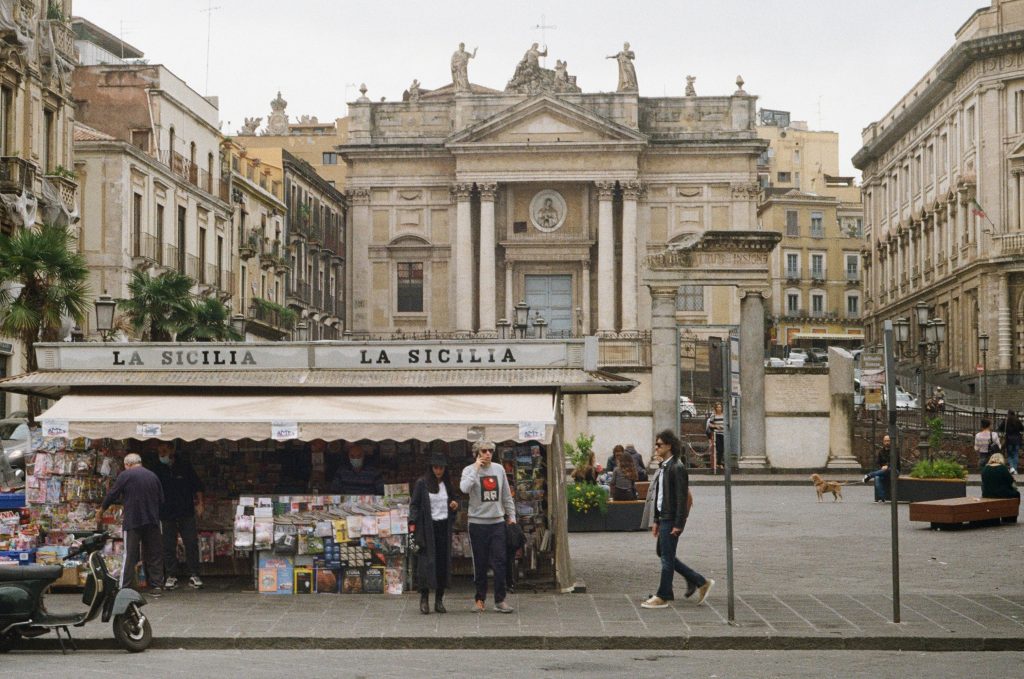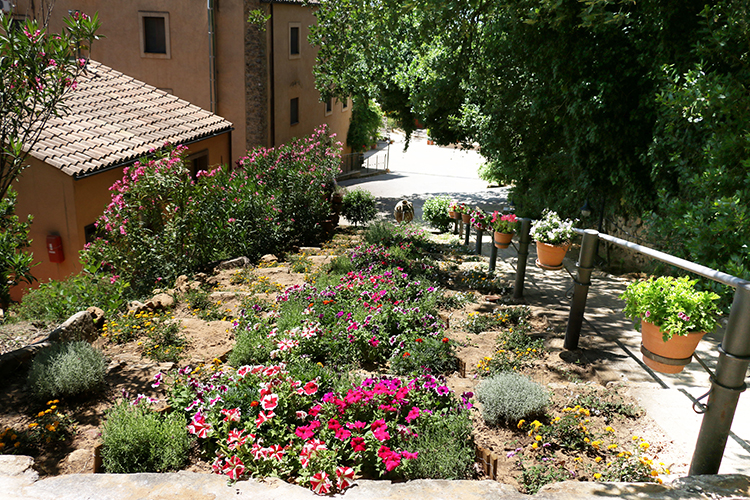Sicily is full of villages, cities and towns as beautiful as rich in history, art and culture. Catania is a real pearl, unique and rare, which stands out from all other places.
Located halfway between the volcano Etna and the sea, its inimitable charm is given by the presence of lava stone, with which is covered the floor of its historic center and have been made several monuments. But not only, because Catania is among the highest expressions of the Baroque, mixed with the art nouveau style and the beauty of marble, proving to be a little gem to be discovered.
Here’s what to see – and not to miss – during a visit to Catania:
Piazza Duomo and Cathedral of Sant’Agata
Among the most famous and characteristic places of Catania, Piazza Duomo hosts some of the most significant monuments: first of all the famous winged elephant (u liotru), undisputed symbol of the city, followed by the Fontana dell’Amenano (water o’linzolu)so called because of the homonymous underground river, and the beautiful Cathedral of Sant’Agata, as well as the Cathedral of Catania.
The latter, in particular, has been rebuilt several times over time due to earthquakes and eruptions on what remained of ancient Roman baths. The facade, by Vaccarini, is in Carrara marble, while the columns come from the ancient Roman theatre.
Palazzo Biscari
Luxurious and elegant, Palazzo Biscari best expresses the richness and sumptuousness that have characterized Catania in past centuries. Inside it is possible to admire frescoes and decorations and to visit the rooms where people of the calibre of Goethe stayed. Its exterior, however, fully represent the so-called “Sicilian Baroque”.
Teatro Massimo Vincenzo Bellini
The Teatro Massimo Vincenzo Bellini is a majestic building, currently composed of an 84-piece choir and an orchestra of 105. Unfortunately, today it is possible to visit only a small part of the original theater, with its frescoed ceiling with images extracted from the most famous works of Bellini, such as the Norma and the Sonnambula.
La Pescheria
The fish market (piscaria) is among the traditional markets of Catania, certainly the most evocative. It is set up every day except Sunday a few steps from Piazza Duomo, behind the Fontana dell’Amenano, up to the Archi della Marina. Among the stalls you can breathe the smell of the sea and hear the screams of sellers, taste local products and buy only excellence, all to live a unique experience.
Castello Ursino
Built by order of Frederick II of Swabia, the Ursino Castle is among the most important buildings and among the symbols of Catania. Of Norman origin, it was the seat of Parliament during the Sicilian vespers, and then became the residence of the Aragonese rulers. Currently, however, it is home to the Civic Museum of Catania and location of temporary and permanent exhibitions.
Roman Theatre and Odeon
Old Catania meets new Catania and, together, live serenely and harmoniously. Among the most modern buildings it is possible to see the Roman Theatre and the Odeon, two historical testimonies dating back to the second century A.D. Today, unfortunately, the Roman Theatre remains very little, but you can still admire the orchestra, the cavea and some parts of the scene; The Odeon, on the other hand, still welcomes many spectators during several summer shows.
Monastero dei Benedettini
The Benedictine Monastery of Catania, also known as the Monastery of San Nicolò l’Arena, is one of the largest and most important monastic complexes in Europe. It boasts 500 years of history, during which it was a refuge for Benedictine monks, barracks and school; currently it houses the Department of Human Sciences of the University of Catania. Now part of the UNESCO World Heritage Site, the Benedictine Monastery includes a large number of wonders, such as the hanging garden, a Roman domus and the burial grounds that can be visited on specific occasions.
Basilica of the Collegiate Church
Along Via Etnea, shortly after Piazza Università, there is the Basilica della Collegiata, also called Regia Cappella: it is a real work of art, among the most significant of the late-Baroque period in Catania. Inside there are many frescoes, while its facade is very fascinating for its shape, so many spouses who choose to marry right here.
Via Etnea
The heart of Catania and shopping street, Via Etna is 3 kilometers long: it starts from Piazza Duomo, passes through Piazza Università and Piazza Stesicoro, reaches Villa Bellini and continues to the former Tondo Gioeni. Wherever you are you can always admire Etna. Much loved by the people of Catania, also and especially in the evening, it is full of baroque palaces built after the earthquake of 1693.
Via dei Crociferi
Following the earthquake of 1963 was also rebuilt Via dei Crociferi, considered by the people of Catania “the baroque living room” par excellence. Declared a UNESCO World Heritage Site, it contains 4 magnificent churches in just 200 meters: the Church of San Benedetto, the Church of San Francesco Borgia, the Jesuit College and the Church of San Giuliano.
Roman amphitheatre
The Roman Amphitheatre of Catania, not to be confused with the Roman Theatre, was among the most magnificent of antiquity, second only to the Colosseum of Rome. Built entirely of lava stone covered with marble, it was able to accommodate about 15 thousand spectators. Today, only a small part remains in Piazza Stesicoro.
Villa Bellini
Halfway along the Via Etnea is Villa Bellini, the place where people from Catania love to relax and play sports. It is a real green lung of about 71 thousand square meters of extension, consisting of gardens, trees of all kinds, sports paths, pitches, hedges, fountains and games for children. On the west side you can walk along Viale degli Uomini Illustri, with busts of local characters such as Giovanni Verga, Mario Rapisardi, Nino Martoglio, Luigi Capuana, Federico De Roberto and the inevitable Vincenzo Bellini.
Orto Botanico
Born at the behest of the Benedictine monk Francesco Tornabene Stronghold in the nineteenth century, the Botanical Garden of Catania currently houses thousands of plant species in 16 thousand square meters of extension and two well-defined sections: Orto Siculo and Orto Generale. Here you can also attend events, training courses and even weddings.

Foto : Unsplash
What to do in Catania
In addition to admiring the places, buildings and monuments listed so far, Catania offers unique opportunities to make unforgettable experiences.
- take an excursion on Etna, on foot or by jeep;
- admire the sunset from San Giovanni Li Cuti, with its black beach and the small seaside village;
- drink a fresh lemon and salt seltz, a typical Catania drink that can quench your thirst during the hottest and hottest days;
- climb aboard the Circumetnea and visit Catania from another perspective, reaching even the villages on the slopes of Etna;
- taste the best arancini of the city from Savia or Spinella;
- take pictures in the district of San Berillo, so suggestive to make anyone fall in love;
- eating horse meat at every corner of the streets or in famous trattorias such as Da Achille, Il Borgo di Fedeico, Na Zà Rosa and Camelot;
- visit the house of Giovanni Verga and, above all, the Casa del Nespolo in Aci Trezza;
- always in Aci Trezza, admire the Faraglioni and Lachea Island eating an ice cream;
- visit the Norman Castle of Aci Castello.
The things to do and see in Catania are really many, especially because the city offers experiences both at the sea, both in the mountains to live at any time of the year. All that remains is to book and try directly on your own skin!
Copertina: Unsplash




